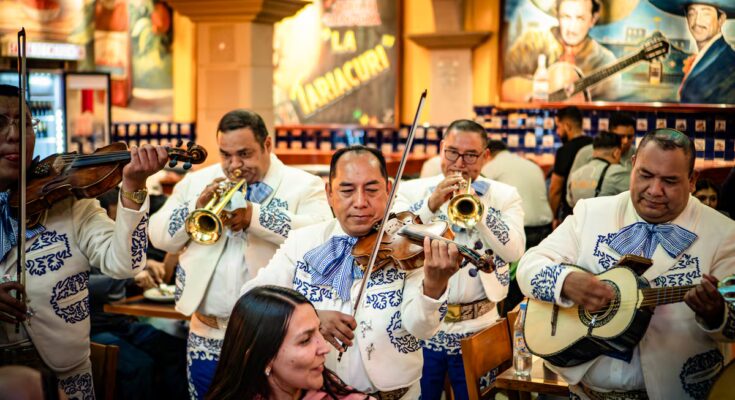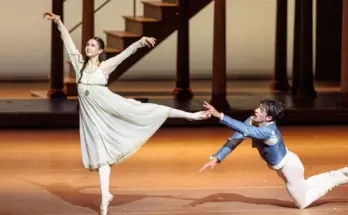Popular legend has it that Chavela Vargas and José Alfredo Jiménez locked themselves away for three nights in the Salón Tenampa, north of Mexico City, drinking shots of tequila and singing to the rhythm of the musicians who wandered among the customers of the large cellar. It is there that, at night, a mariachi group begins to perform one of the classics of Paquita la del Barrio, Three times I have deceived you: “You who left me / I who was waiting for you (…)”. Sitting at one of the tables, Daniel Gómez closes his eyes. He clenches his fist and shakes it to the beat of the music. Sings with meaning: “I who foolishly / have always been faithful to you.” The tables in the restaurant are almost full, the mariachis go around offering songs to the customers and the waiters serve the tables with harmony, like musicians in an orchestra. It’s a Wednesday evening at Tenampa Hall, the capital’s great mariachi emblem, which turns 100 this Saturday.
The mariachis continue surrounding Daniel Gómez’s table, who moves his shoulders accompanying the sound of the violins. It’s the first time he’s set foot in that place. He comes from Los Angeles, California, and is accompanied by a group of friends: “The place is super Freddo (Don’t worry). Imagine coming to the other side and experiencing this.” A large painting by Pedro Infante and Jorge Negrete presides over the Tenampa Room, surrounded by portraits of other great music artists, Juan Gabriel, Chavela Vargas. Employees say that on busy days about 800 people can pass through; about 200 when things slow down.
Marcos Montes (Mexico City, 57 years old) emphasizes that the music never stops playing in this place. She wears a light beige charro dress with gold details and a bluish scarf hangs from her neck, the uniform of the Mariachi Guadalajara. He says his father performed at the winery for 50 years and that he is already 38. “Garibaldi (the square that encompasses the venue) is full of mariachis, but Tenampa is an emblematic place,” he says.
Montes grabs the violin and joins his companions. start singing This jealousyby Vicente Fernández: “I looked at you. You were so pretty, so sensual (…)”. Two customers sing the chorus. Mariachi Guadalajara is one of those chosen by the Mariachi Congress agreement to perform in Tenampa. No one who performs in the square can enter without that license. Montes says Garibaldi can host about 2,000 mariachis on weekends, and about seven perform in Tenampa. He likes to sing The suns of Jalisco (“it is something that represents us”); but what they ask of him most is to sing divine women, Huasteca Serenade, This jealousy OR How can I forget you.
‘Embarrassing’ and a plate of birria
The trumpets sing the signature melody of the controversial song kill themby Alejandro Fernández. The composer of that and other similar songs two-legged ratManuel Eduardo Toscano (Catemaco, Veracruz, 73 years old), remembers one of the mischievous comics that happened to him there in his first years as an author, several decades ago. He left the Discos Orfeón studios with artistic director Jorge Nájera – now deceased – where they recorded the clown Cepillín. “We were going clumsyand we ordered a beer. They served it to us, but it was already dawn and they had poured a lot of water into it. So we didn’t like it,” he recalls. That night, Nájera tells him not to worry (“we won’t pay for it”) and plucks a hair, throws it in the beer and calls the waiter. “This one brings a hair. “We don’t want anything anymore,” he tells her.
Toscano is happy when he assures that Tenampa “really” has value. “It’s so important that composers like Don Pepe Guízar wrote songs for this (My Tenampaplayed by Pedro Infante). Those songs went around the world giving the place its name. So it is still very important for the history of the mariachi,” he explains. He emphasizes that visiting the Garibaldi without setting foot in the cellar leaves a void, and continues: “Certainly the mariachi, since he spends every day (there), no longer gives it so much importance, but for me as a composer it is very important.”
The colored pieces of paper hanging from the ceiling warn of the centenary: “Tenampa 100”. Fernanda Aguilera (State of Mexico, 37 years old) is the great-granddaughter of the first owner, Juan I. Hernández. The business has always been in his family. Since he was 22, he has run the place together with his mother, after his father’s death. “Since I was little I didn’t realize the magnitude of what this place was. For me it was simply a reality, the family parties, the baptisms, the celebrations. (…) My mission has always been to preserve the legacy of the family and the place,” she says. Aguilera is very clear about the strengths that have led the place to continue 100 years later and during the conversation she pronounces some maxims in this regard: “El Tenampa is living history”; “in Tenampa you experience this identity of flavours, colours, smells and sounds of a Mexico that seems very ancient, but which is today”; “It’s international because it positions itself as the place where you can hear this formalized band. Before the (mariachi) bands were on the streets.”
José Alfredo Jiménez and a tequila
At the doors of the club, Saúl Palacios (State of Mexico, 23 years old) shows one of his best smiles in front of the camera. He is one of the workers who has been serving customers for three years. He believes Tenampa’s success is due to the illustrious people who have visited it, but also “the preservation of Mexican traditions.” “I have been working here for three years and the truth is that it has been a very pleasant experience for me. It is a place that preserves traditions and welcomes the general public,” he says.
Palacios says an essential part of the venue is promoting the legacy of mezcal and tequila, the two most successful drinks. On their menu there are cocktails like mezcalitas or margaritas (“traditional drinks you absolutely have to try,” he says), but the pomegranate punch stands out, a mixture of tequila, pomegranate and walnut pieces, the complete recipe of which only a man from Tapatío known as Jerry knows. What are the most successful dishes? “Our essence is Jalisco. Something that is never missing here are the quesabirrias, the birria, the pozole, the poached cake. And the Tenampa botana, a dish with Mexican garnacha that puts all the Mexican gastronomy on one plate.”
In Tenampa we live in a Mexico that seems very ancient, but today
Fernanda Aguilera, owner of Sala Tenampa
The author of Sunny days, taco nightsAlonso Ruvalcaba (Mexico City, 52 years old), read an article from 25 years ago on “mariachi gastronomy” in the American magazine Saveurand since then it has been the name of the food served in the premises of Piazza Garibaldi. “This type of cuisine is more similar to that of Tlaquepaque (a municipality near Guadalajara). There are some dishes that are very particular to the municipality, not to Jalisco as a whole, such as the michi broth, a particular type of birria, the tatemada or the machitos,” he signs. And he explains: “The Tenampa is more like the filtered and cleaned version of that. Tlaquepaque also bleached that food, because its main sale is to people who don’t live there, but to those who go there. peda”.
The reporter also says that 30 years ago the square that embraces Tenampa “was one party” “It was the only place where you could drink on the street without having to be in a place (…) This has changed, because the city has changed and polished itself up to welcome more people who came to spend,” he says. It was the place where he went in the name of danger, tempted to live some adventure that could end in an epic night or locked up in a prison: “When I came to live in the center, about 22 years ago, I still sometimes went to Plaza Garibaldi to get weed or coke. Everything that has already changed in this sense. Tenampa has also changed.”
Palacios says that before the place was just a canteen and that the gastronomic offer was introduced later. For Ruvalcaba this reversal of trend is a sign that the restaurant has been able to read the changes in its clientele. “Considering that it is still open, it is a triumph. If it already lasts 100 years, it is a success. The only thing that matters in restaurant life is selling and surviving,” he explains. He says the big change has been noticed since the early 2000s: “Before (Garibaldi) was the most vomiting square in Mexico, now it’s like a tourist attraction, which is not a bad thing.”
José Luis Hernández (Mexico City, 61 years old) rests his chin on his large harp, as if time is beginning to weigh on the cellar. She wears a white dress, a little more modest than the charro. It is the uniform of the Mariachi Jarocho, the group with which he has attended Tenampa for 46 years, more than half his life. “(Being part of that history) is a very beautiful thing. It’s something that has always been with you: one with Tenampa; Tenampa with you. I think I live more in Tenampa than in my home,” he says. And he says: “Being part of Tenampa is something inexplicable.” Like Montes, the topic that gets asked the most is Huasteca Serenade. When he mentions it, he points to the large painting to his right, in which José Alfredo Jiménez, the author of the song, appears.
The music did not stop playing for a single minute throughout Piazza Garibaldi. Something similar happened within Tenampa. The scenes divide the space like frames: Daniel Gómez sings at one of the tables, an Asian couple gets up and starts dancing to the mariachi rhythm. In the center of the room, the violins begin to accompany the guitars to interpret The bikinia classic of Mexican music composed by Rubén Fuentes: “Haughty, beautiful and proud / Does not allow her to console herself (…)”. The night seems to have no end in the living room.



